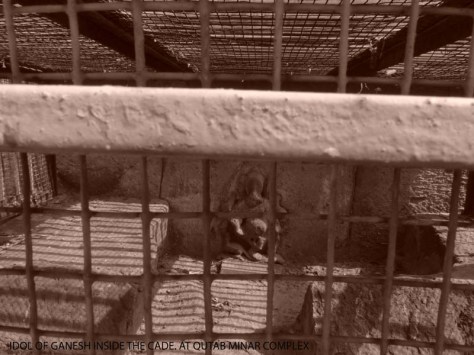Islam has its roots in central Asia from where it spread all over the world. Islamic emperor from Persian and other parts of the world invaded the rich land of India initially and later made this country their home. They ruled here for some centuries and were defeated at the hands of British empire later.
I was with my friend Nishant Saxena at Qutab Minar complex on 22nd June, 2013. Our sole purpose was to study Indo-Islamic structure which were a resultant of amalgamation of Hindu architecture represented in Islamic style. And Qutab Minar is finest example of architectural wonder created by slave dynasty in Delhi.
Apart from the tower, there were many other tombs and monuments inside the complex. Mehrauli Archeological Site is also nearby. One can always visit these structure from sunrise to sunset.
Our sole purpose was to explore what was discovered. But what we discovered, unfortunately could not be explored. It was destroyed to grounds, pulverized, fragmented or left to ruins.

Qutab complex stands on what could be a Hindu Temple Complex. This is evident from the fact that we can still witness the remains of the intricate carvings of floral patterns and sculptures on walls and columns. Here take a look.



This was quiet unexpected. I wonder why was the idol kept hidden from the public’s eye. It was wonderful of lord to grant me his ‘darshan‘ as I bow down in gratitude to take his photograph.




I think that this temple was dedicated to lord Vishnu. His temples were more ornamented than those of the hermit god Shiva.


The Idol above depicts an individual with human head and torso and lower body of a serpent. This could be the asur Ketu, one who caused lunar eclipse.


I can visualize the era when this temple complex displayed the grandeur which speak in the name of the God. If it had survived to this date, it would be at par to those temples of southern India. The relics of the temple are enough to say that Indian architects already knew of what the world said that they don’t know.
We ended our time witnessing the sunset at victory tower which man has erected over the chest of God. I have been here many times before. But this was the first time I saw God residing at this place.

keen observers!
haaaa…. thank you…..
it can also be said as – proofs of the existence of Hindu-Jain Architecture at Qutab Complex
A very good effort.A small beginning towards a much larger picture.We are losing our cultural heritage at an alarming rate due to our callous attitude.Lets not start a blame game,rather if students of architecture ,history and the common people start making tiny efforts towards documentation ,building awareness and making others aware about this loss, if any, that comes to their notice,I am sure our future generation will have a lot to thank the people concerned. Thanks a lot Aman and Nishant for this .Best of luck on this exploration.
Very good effort Nishant and aman. As I heard it is the place of varahmihir’s ( Now named as mehruli) observatory. But a very good observation of hinduism marks and gods on remains. keep it up. Your identification of god’s idol is very fantastic . it is very clear that 3rd idol of dashaavtar is Varha-Avtar.
We all go to qutab minar …… but this is architects point of view……..thank you for the compliments
Thank you very much everyone, we wud love to have more information on all the things and please tell us if there are any corrections to be made